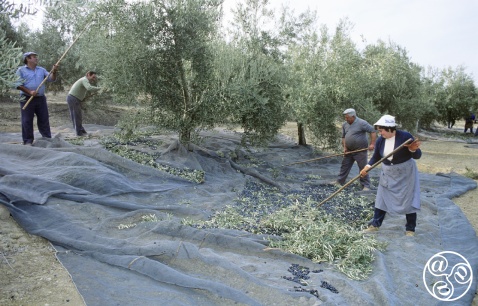
The traditional form of Olive harvesting in Andalucia © Michelle Chaplow |
|
Olive Trees
The species of olive tree growing in neat rows across Andalucia today is the Olea Europeae. It is sufficiently important to have inspired the Regional Government to track every commercial tree. In fact each one has its own GPS co-ordinates and is carefully monitored by officials to ensure correctness for EU subsidies.
Within this species, there are various cultivars or varieties, each with specific characteristics like fruit size, oil content, and ripening time.
Picual: This is the most widely cultivated variety in Spain, including Andalusia. It is known for its high oil yield, hardiness, and resistance to diseases. Picual olives produce a robust and slightly bitter oil with a fruity flavor.
Hojiblanca: Primarily grown in Andalusia, Hojiblanca olives produce a delicate and sweet oil with a slightly nutty flavor. They are also popular for table olives due to their meaty texture and mild flavor
Manzanilla: Another Andalusian variety, Manzanilla olives are primarily used for table olives. They have a meaty texture, a slightly salty flavor, and produce a mild and slightly sweet oil with a nutty flavor
Verdial: This variety is particularly well-suited to the Málaga region. Verdial olives produce a fruity and aromatic oil with a medium intensity
Lechín: This variety is found in several Andalusian provinces, including Granada, Sevilla, and Córdoba. Lechín olives produce a fruity and slightly bitter oil
 |
| Olive Harvest |
2.4 million hectares of olive trees
Spain is undoubtedly the world leader when it comes to olive production. This country dedicates 2.4 million hectares of land to this valuable crop. Italy and Greece are the other two world heavy weights with over 1.4 million hectares and more than 700,000 respectively. As a note of interest the trees in Italy and Greece have a slightly higher yield than those in Spain.
In ancient times it was believed that olive trees had to be planted near the sea in order to thrive, but modern agricultural techniques have overcome such barriers. One thing hasn’t changed, however, and that is the olive tree’s love of tough, rocky soil and craggy limestone cliffs. Perhaps surprisingly, these hearty trees produce better fruit and oil in poor soil than they do in rich, fertile earth.
No one can be sure that the variety of olive trees thriving in Spain today are direct descendents of the much praised versions that grew in Greece and Rome – or even ancient Egypt, for example. But it is supposed they are at least similar, and the fact that these historical trees are still cultivated does provide locals with a strong connection to past centuries.
It is well known that olive trees were cultivated in the south of Spain during Roman times. Numerous artefacts are testimony to the olive’s importance throughout the known history of the Iberian Peninsula – and these include old stone olive presses and other paraphernalia used to process this precious crop.
Plant your own olive tree
If you wish to plant an olive tree that will produce good fruit, be sure to consult with a local expert in your area. Olive trees need to be properly prepared and grafted in order to yield a decent crop.
if you wish to grace their gardens with a beautiful, gnarly old tree. With some luck, it may be possible to locate one of the organisations dedicated to saving centuries old olive trees from construction sites (for roads, golf courses and other projects) and then finding “homes” for them. Rather than purchasing the tree, the new owner simply pays for the salvaging, storage and replanting. Garden centres also offer well developed mature trees.
